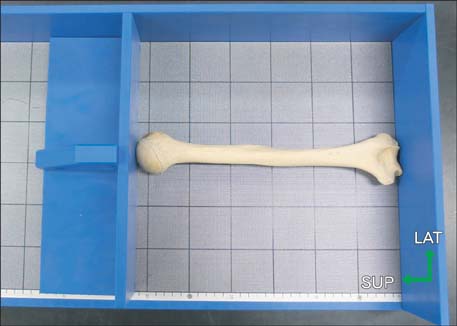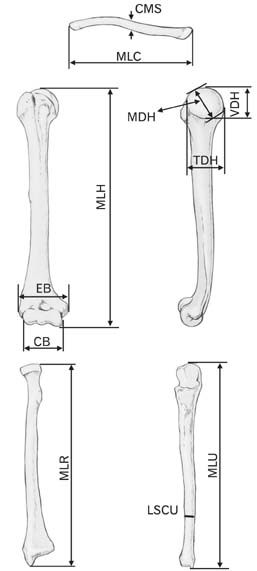Anat Cell Biol.
2014 Sep;47(3):196-201. 10.5115/acb.2014.47.3.196.
Sex determination using upper limb bones in Korean populations
- Affiliations
-
- 1Department of Anatomy, Konyang University of Korea College of Medicine, Daejeon, Korea.
- 2Department of Anatomy, Ewha Women University School of Medicine, Seoul, Korea.
- 3Department of Anatomy, Catholic Institute for Applied Anatomy, The Catholic University of Korea College of Medicine, Seoul, Korea.
- 4Department of Anatomy, Soonchunhyang University College of Medicine, Cheonan, Korea.
- 5Department of Anatomy, Chung-Ang University College of Medicine, Seoul, Korea. hsh@catholic.ac.kr
- KMID: 1882595
- DOI: http://doi.org/10.5115/acb.2014.47.3.196
Abstract
- The purpose of this research is to establish metric standards for the determination of sex from the upper limb bones of Korean. We took a set of eleven measurements on each of 175 right sides of adult skeletons chosen at Korean sample. Classification accuracy dropped only one or two individuals when only vertical head diameter of humerus is used. Variables in relation with maximal length were less accurate than head diameter of humerus. Two variables were selected by the stepwise procedure: maximal length of humerus, vertical head diameter of humerus. The combined accuracy was 87%. This study of modern Korean skeletons underscores the need for population-specific techniques, not only for medicolegal investigations, but also for the study of population affinities and factors affecting bone configurations.
Figure
Reference
-
1. Dittrick J, Suchey JM. Sex determination of prehistoric central California skeletal remains using discriminant analysis of the femur and humerus. Am J Phys Anthropol. 1986; 70:3–9.2. Kranioti EF, Bastir M, Sánchez-Meseguer A, Rosas A. A geometric-morphometric study of the Cretan humerus for sex identification. Forensic Sci Int. 2009; 189:111.e1–111.e8.3. Ross AH, Manneschi MJ. New identification criteria for the Chilean population: Estimation of sex and stature. Forensic Sci Int. 2011; 204:206.e1–206.e3.4. Singh S, Singh SP. Identification of sex from the humerus. Indian J Med Res. 1972; 60:1061–1066.5. Holman DJ, Bennett KA. Determination of sex from arm bone measurements. Am J Phys Anthropol. 1991; 84:421–426.6. Işcan MY, Loth SR, King CA, Shihai D, Yoshino M. Sexual dimorphism in the humerus: a comparative analysis of Chinese, Japanese and Thais. Forensic Sci Int. 1998; 98:17–29.7. Steyn M, Işcan MY. Osteometric variation in the humerus: sexual dimorphism in South Africans. Forensic Sci Int. 1999; 106:77–85.8. Vance VL, Steyn M, L'Abbé EN. Nonmetric sex determination from the distal and posterior humerus in black and white South Africans. J Forensic Sci. 2011; 56:710–714.9. Safont S, Malgosa A, Subirà ME. Sex assessment on the basis of long bone circumference. Am J Phys Anthropol. 2000; 113:317–328.10. Mall G, Hubig M, Büttner A, Kuznik J, Penning R, Graw M. Sex determination and estimation of stature from the long bones of the arm. Forensic Sci Int. 2001; 117:23–30.11. Ríos Frutos L. Metric determination of sex from the humerus in a Guatemalan forensic sample. Forensic Sci Int. 2005; 147:153–157.12. Barrier IL, L'Abbé EN. Sex determination from the radius and ulna in a modern South African sample. Forensic Sci Int. 2008; 179:85.e1–85.e7.13. Kranioti EF, Nathena D, Michalodimitrakis M. Sex estimation of the Cretan humerus: a digital radiometric study. Int J Legal Med. 2011; 125:659–667.14. Kranioti EF, Michalodimitrakis M. Sexual dimorphism of the humerus in contemporary Cretans: a population-specific study and a review of the literature. J Forensic Sci. 2009; 54:996–1000.15. Uzün I, Işcan MY, Celbiş O. Forearm bones and sexual variation in Turkish population. Am J Forensic Med Pathol. 2011; 32:355–358.16. Charisi D, Eliopoulos C, Vanna V, Koilias CG, Manolis SK. Sexual dimorphism of the arm bones in a modern greek population. J Forensic Sci. 2011; 56:10–18.17. Milner GR, Boldsen JL. Humeral and femoral head diameters in recent white American skeletons. J Forensic Sci. 2012; 57:35–40.18. Bašić Ž, Anterić I, Vilović K, Petaros A, Bosnar A, Madžar T, Polašek O, Anđelinović Š. Sex determination in skeletal remains from the medieval Eastern Adriatic coast - discriminant function analysis of humeri. Croat Med J. 2013; 54:272–278.19. Rogers TL. A visual method of determining the sex of skeletal remains using the distal humerus. J Forensic Sci. 1999; 44:57–60.20. Tanaka H, Lestrel PE, Uetake T, Kato S, Ohtsuki F. Sex differences in proximal humeral outline shape: elliptical Fourier functions. J Forensic Sci. 2000; 45:292–302.21. Choi BY, Chung IH. Sex discrimination with the metric measurements of the Korean dried pelvic bones by discriminant function analysis. Korean J Phys Anthropol. 1999; 12:151–158.22. Choi BY, Lee KS, Han SH, Park DK, Lim NH, Koh KS, Kim HJ, Kang HS. Group analysis using the metric measurements of Korean skulls. Korean J Phys Anthropol. 2001; 14:207–215.23. Park DK, Lee UY, Lee JH, Choi BY, Koh KS, Kim HJ, Park SJ, Han SH. Non-metric traits of Korean skulls. Korean J Phys Anthropol. 2001; 14:117–126.24. Ji EK, Rhyu IJ, Cheon YH, Lee EK, Kim YM, Shin DY, Hwang SJ. Gender difference of corpus callosum in Korean neonate. Korean J Phys Anthropol. 2001; 14:333–338.25. Rhyu IJ, Ryu JY, Park KW, Lee DH, Park KY, Park KH, Hwang SJ. Gender difference on corpus callosum in Korean adults. Korean J Phys Anthropol. 2005; 18:169–177.26. Kim DI, Lee UY, Park DK, Kim YS, Han KH, Kim KH, Han SH. Morphometrics of the hyoid bone for human sex determination from digital photographs. J Forensic Sci. 2006; 51:979–984.27. Park DK, Kim DI, Lee UY, Han KH, Kim KH, Han SH. Morphometric analysis of the Korean thyroid cartilage for identification of sex: metric study. Korean J Phys Anthropol. 2003; 16:129–136.28. Hu KS, Koh KS, Park KK, Kang MK, Chung IH, Kim HJ. Non-metric traits of Korean mandibles. Korean J Phys Anthropol. 2000; 13:161–172.29. Hu KS, Koh KS, Jung HS, Kang MK, Choi BY, Kim HJ. Physical anthropological characteristics and sex determinative analysis by the metric traits of Korean mandibles. Korean J Phys Anthropol. 2000; 13:369–382.
- Full Text Links
- Actions
-
Cited
- CITED
-
- Close
- Share
- Similar articles
-
- Sex estimation from upper limb bones in a Thai population
- Sex Discrimination with the Metric Measurements of the Korean dried Pelvic Bones by Discriminant Function Analysis
- Statistic Approach for Sex Differentiation of Dried Korean Pelvic Bones
- Estimation of Maximum Tibia Length from Fragmentary Condition in Korean Populations
- Serially Sectioned Images of the Whole Body (Eighth Report: Segmentation of the Upper Limb's Structures)



